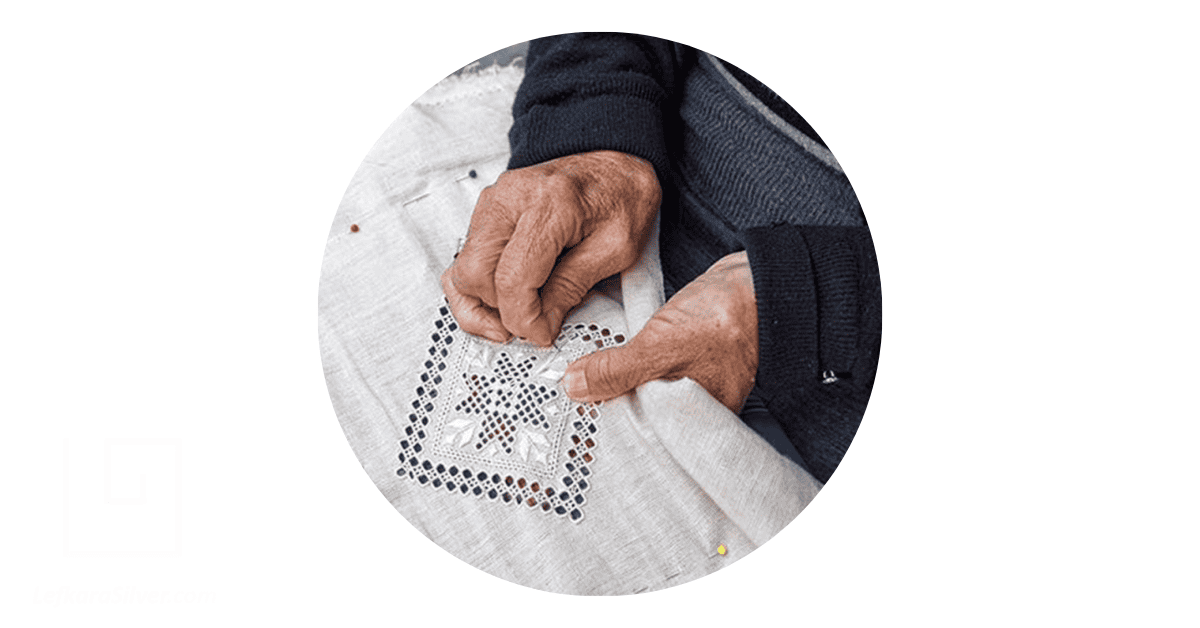
New Cyprus Lace Guide: 7 Best Shops & Lace-making Villages in 2025
So, you think you know lace? Think again. We’re about to unravel the story of a textile so special that it’s considered a cultural treasure. Forget dusty doilies in your grandma’s attic; Cyprus lace is a living, breathing art form with a history as rich and intricate as its patterns. It’s a craft that captivated Leonardo da Vinci and remains the pride of this Mediterranean island. Get ready to explore the villages where this tradition was born and is still passionately preserved.
An Introduction to Cyprus lace
At its heart, Cyprus lace is more than just a beautiful souvenir; it’s a profound piece of cultural identity. Known locally as Lefkaritika from its most famous village, Lefkara, this craft is a testament to the incredible skill and patience of the island’s lacemakers, a tradition passed down through generations. This is a story woven in thread, a craft so vital to the island’s heritage that it has earned a prestigious spot on the UNESCO Intangible Cultural Heritage list.
This in-depth guide, updated as of September 2025, will walk you through every facet of this remarkable art. We’ll cover:
- Cyprus lace statistics – September 2025
- Top picks: The 7 must-visit Cyprus lace shops
- The history of Cyprus lace
- Where is the best lace making village in Cyprus?
- Lefkara lace: The pride of Cyprus
- Omodos lace
- The weaving tradition of Fyti lace
- Cyprus lace techniques and unique Cyprus embroidery
- The influence of Cyprus lace on fashion
- Cyprus lace tourism tips
Cyprus Lace Statistics – September 2025
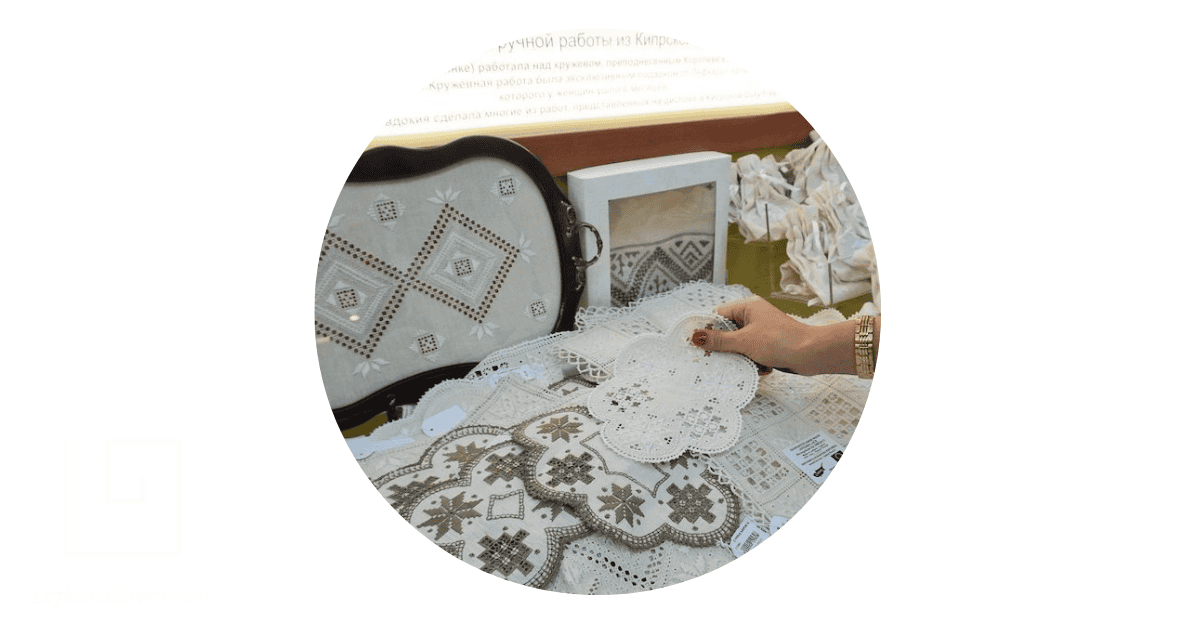
To truly appreciate the scale and significance of Cyprus lace, let’s dive into the data. We’ve meticulously researched and verified every fact and figure, ensuring you get the most accurate and insightful information available.
- The celebrated tradition of Lefkara lace, or Lefkaritika, dates back to at least the 14th century.
- This intricate handicraft was officially added to the UNESCO Representative List of the Intangible Cultural Heritage of Humanity in 2009.
- Legend has it that Leonardo da Vinci himself visited Cyprus in 1481 and was so impressed that he purchased a large lace piece to serve as an altar cloth in Milan Cathedral.
- Completing a single, large, and complex Lefkara tablecloth can take a skilled artisan well over a year.
- The knowledge of Lefkaritika is traditionally passed from mother to daughter, preserving the craft within the family.
- The design vocabulary of Lefkara lace is vibrant, featuring over 600 distinct motifs.
- In May 2025, the value of Cyprus’s exports of special woven fabrics and lace was recorded at $0.02 million.
- The peak for these exports was $1.83 million in March 1996.
- Conversely, Cyprus imported $0.31 million worth of special woven fabrics, a category that includes lace, in May 2025.
Top Picks: The 7 Must-Visit Cyprus Lace Shops
When you’re ready to find that perfect piece of authentic Cypriot lace or silver, the sheer number of shops can be overwhelming. That’s why we’ve curated this list. The following shops have been selected based on glowing customer reviews, proven reliability, and a consistent offering of high-quality lace and filigree silver, abundant in Cypriot Filigree History.
For the most authentic experience, your journey should begin in Pano Lefkara, the heartland of traditional Cypriot embroidered lace, known as lefkaritiko. This village is a treasure chest of shops, each overflowing with handcrafted masterpieces.
1. Lefkara Arts & Crafts
Nestled in Pano Lefkara, this shop is a go-to for those seeking both handmade silver and the region’s famous lace. It represents the dual-craftsmanship that makes the village so unique, where the intricate work of the silversmith is sold alongside the delicate creations of the lacemakers.
2. Rouvis Lace and Silver
Also located in Pano Lefkara, Rouvis is celebrated for its fantastic family-run atmosphere. They offer beautiful silver and gold jewelry right alongside handmade “LEFKARITIKA” embroidery. With a strong reputation and positive visitor reviews, it’s a place where you can feel the family pride woven into every item.
3. Da Vinci Handmade Lace-Center
Situated in the capital city of Nicosia, the Da Vinci Handmade Lace-Center is a hub for Cypriot culture. Beyond just lace, it offers a broader collection of clothing and jewelry, making it a convenient stop for those looking to experience the island’s artistry without venturing into the villages. It’s a place where you can find a piece of Cyprus’s artistic soul.
4. Helen’s Lace Shop
For those in Nicosia with a singular focus on lace, Helen’s Lace Shop is a prime destination. It is renowned for its extensive and diverse selection of Lefkara lace, providing a detailed exploration of the various patterns and styles that make this craft so distinctive.
5. Karagiorgi Maroulla
Another gem in Nicosia, Karagiorgi Maroulla provides a unique selection of handcrafted lace. This shop offers a more curated experience, ideal for the discerning buyer seeking a piece that stands out from the rest.
6. A & E Stores
If your travels take you to Limassol, A & E Stores on Agiou Andreou Street is a key destination for lace lovers. Its location in a bustling coastal city makes it an accessible spot to find authentic, high-quality Cypriot lace.
7. L.Papaloizou-Cardiff Lefkara Lace Workshop & Silver
This wonderfully named shop in Pano Lefkara is praised as a “fantastic family business” and a must-visit. Visitors highlight the entertaining and kind family who run the workshop, offering not just beautiful filigree silver and lacework, but also fascinating insights into their craft.
Be sure to check out our Filigree Jewelry collection to see how the beautiful legend of Lefkara lace inspires our designs.
The History of Cyprus Lace
Cyprus has long made its stamp on history, and its tradition of lace-making is a vibrant thread in that rich tapestry. The story of Lefkara lace, or Lefkaritika, is one of cultural fusion, female empowerment, and incredible artistry that has been passed down through centuries. We’ve been paying close attention to how this ancient craft has evolved and maintained its prestige.
The tale begins in the village of Pano Lefkara and dates back to at least the 14th century. However, it was during the Venetian rule, starting in 1489, that the craft truly began to transform. Local Cypriot women, already skilled in their native embroidery, were influenced by the intricate needlework of the Venetian noblewoman.
They didn’t just copy the Italian styles; they adapted them, blending them with ancient Greek and Byzantine geometric patterns to create a unique hybrid art form. This evolution from an older style called “asproploumia” into the Lefkaritika we know today was driven by the skill and creativity of the island’s embroideresses.
Lace-making became central to the lives of women in Lefkara, serving as both a primary occupation and a proud symbol of their identity. An extensive collection of lace was a crucial part of a young woman’s dowry, to be exhibited on her wedding day. While the women, known as “ploumarisses”, crafted the lace, the men, called “kentitarides”, took on the role of merchants. These men traveled across Europe and Scandinavia, selling the exquisite lacework and creating vital economic lifelines for their village.
Perhaps the most famous story associated with Lefkara lace is that of Leonardo da Vinci. According to tradition, da Vinci visited Cyprus in 1481 and purchased a large lace altar cloth, which he then gifted to the Duomo Cathedral in Milan. This legendary endorsement speaks to the supreme quality and beauty of the craft. In 2009, this profound cultural tradition was officially recognized and inscribed on the UNESCO Representative List of the Intangible Cultural Heritage of Humanity.
Where is the Best Lace Making Village in Cyprus?
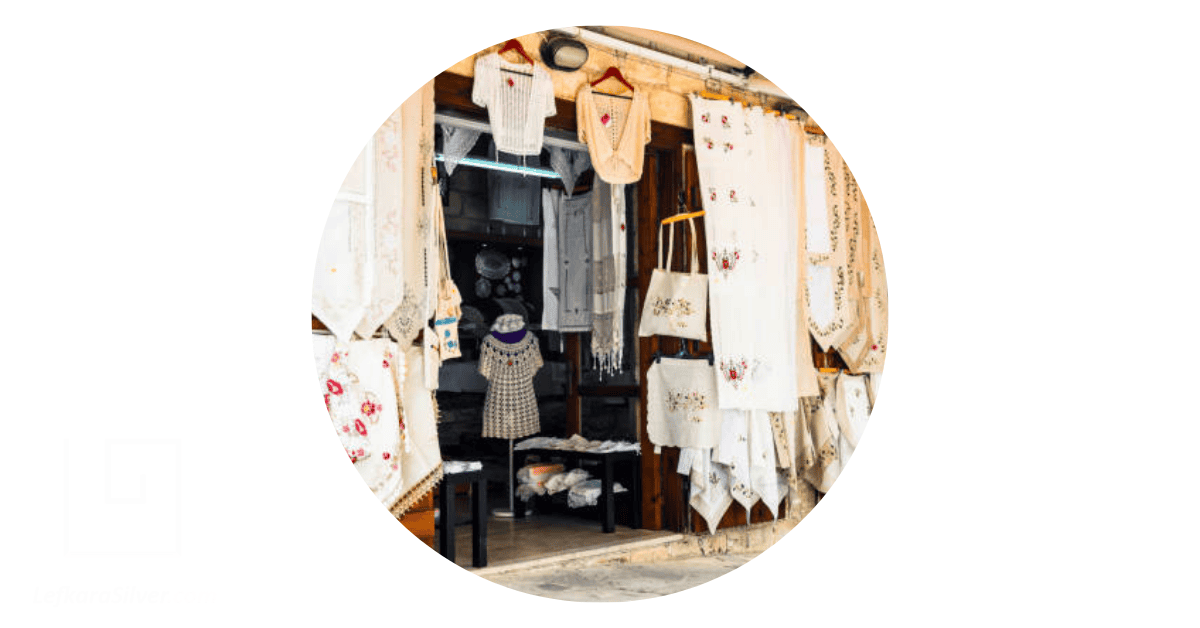
The tradition of lace-making is woven into the very fabric of Cyprus, a cherished craft preserved in the quiet streets of its mountain villages. While many villages practice this art, one stands head and shoulders above the rest as the undisputed capital of Cypriot lace.
Without a doubt, Pano Lefkara is the most famous and celebrated lace-making village in Cyprus. Nestled in the foothills of the Troodos Mountains, this picturesque village is where Lefkaritika was born and perfected. Its name is synonymous with the craft. Here, the tradition is a living spectacle; you can still see women sitting in their doorways, their fingers moving with practiced grace as they work on intricate patterns.
The village itself, with its charming stone-built houses and cobbled lanes, feels like a living museum. It’s not just the history but the sheer concentration of high-quality workshops and the palpable sense of heritage that make Pano Lefkara the ultimate destination for any lace enthusiast.
Other Lace-Making Villages to Explore
While Pano Lefkara gets the spotlight, the art of textile craftsmanship flourishes in other villages across the island, each with its own unique identity.
- Omodos: Famous for its “pipilla” or narrow-knit lacing, Omodos is a key center for this distinct style of needlework. The craft is so important that there is a dedicated Centre for the Preservation of Narrow-Knit Lacing within the village monastery.
- Fyti: This village in the Paphos district is the heart of a different textile tradition: weaving. Known for its “Fythkiotika,” colorful woven fabrics with distinctive geometric patterns called “ploumia,” this craft is believed to date back to the Middle Ages.
- Kato Lefkara: The “lower” counterpart to Pano Lefkara, this village was also a significant center for lace production.
- Other Villages: The tradition of Lefkaritika has spread to many other villages, including Kato Drys, Vavla, Vavatsinia, Ora, Choirokoitia, Skarinou, Dali, and Athienou, all of which contribute to keeping the craft alive.
Here is a quick guide to the key craft villages:
| Village | Primary Craft | What Makes it Special |
|---|---|---|
| Pano Lefkara | Lefkaritika (Lefkara Lace) & Filigree Silver | The main center for traditional weaving with vibrant, geometric patterns dates to medieval times. |
| Omodos | Pipilla (Narrow-Knit Lace) | A major center for this unique needle lace, with a dedicated preservation center. |
| Fyti | Fythkiotika (Woven Fabrics) | The main center for traditional weaving with vibrant, geometric patterns dating to medieval times. |
| Kato Lefkara | Lefkaritika (Lefkara Lace) | A historically significant lace-making village neighboring the main center of Pano Lefkara. |
| Kato Drys | Lefkaritika & Silverwork | A village that continues the tradition of Lefkara embroidery and is also known for silver craftsmanship. |
These villages are the heart of Cyprus’s lace-making tradition, each contributing to the preservation and continuation of this beautiful craft. But now, let’s spotlight Lefkara, Omodos, and Fyti Lacing.
Lefkara Lace: The Pride of Cyprus
When it comes to Cypriot crafts, Lefkara lace isn’t just a player; it’s the star player, the team captain, and the hall-of-fame all rolled into one. This isn’t just embroidery; it’s a specific and grueling form of pulled-thread work, where threads are painstakingly cut and pulled from linen fabric, and the remaining threads are then intricately stitched over.
The result is a masterpiece of geometric patterns and delicate beauty, a tradition so significant it was added to the UNESCO Intangible Cultural Heritage list in 2009. This unique blend of local craft, ancient Greek and Byzantine geometry, and Venetian artistry makes Lefkaritika a true cultural symbol of the island.
The market for this exquisite lace is robust, but it comes with a caveat: authenticity is everything. Given that a single large tablecloth can take a year or more to complete, genuine Lefkara lace carries a price tag that reflects its artistry and the immense labor involved in its creation. This has inevitably led to imitations.
You’ll find “Lefkara-style” pieces, but a true Lefkaritiko is handmade in Cyprus, utilizing specific techniques passed down through generations. Discerning a genuine piece from a machine-made knock-off is crucial for anyone looking to invest in this heritage craft. We looked into this thoroughly.
What to Look For When Buying Lefkara Lace
- Check the Material: Authentic Lefkaritika is made exclusively on Irish or French linen. It should feel crisp and natural.
- Examine the Back: Flip the piece over to view the other side. A handmade item will be almost as neat on the back as on the front, a hallmark of a skilled artisan. A machine-made piece will often look messy or have tell-tale looping on the reverse.
- Look for Imperfect Perfection: A handmade item will have minute, almost imperceptible variations in the stitches. This isn’t a flaw; it’s the signature of the human hand. Machine work is often too uniform and mechanically perfect.
- Ask Questions: Talk to the shop owner. Ask where the piece was made and, if possible, who the artisan was. In villages like Lefkara, the sellers are often the makers themselves or their family members and are proud to share the story behind their work.
Here are four popular categories of lace you’ll find in Cyprus:
- Table Linens: This is the most iconic category, ranging from small coasters to enormous tablecloths that can serve as family heirlooms.
- Decorative Pieces: Items such as doilies, runners, and wall hangings showcase intricate patterns in a smaller format.
- Altar Cloths: Following the legendary purchase by Leonardo da Vinci, large-scale, elaborate altar cloths remain a pinnacle of the craft.
- Fashion and Accessories: Modern artisans incorporate lace into clothing, from small details on blouses to full christening gowns and handkerchiefs.
Omodos Lace
While Lefkara takes the lion’s share of the glory, venture to the wine-producing village of Omodos and you’ll discover another, equally fascinating, thread in Cyprus’s textile story: pipilla lace. This is a completely different technique, a delicate and intricate needle lace that is just as breathtaking in its complexity. The village is so proud of this heritage that it has established the Centre for the Preservation of Narrow-Knit Lacing, located within the historic Holy Cross Monastery.
Known as narrow-knit lacing, pipilla is characterized by its fine, dense stitches and incredibly detailed patterns. The motifs are often inspired by nature, with designs like the “potamos” (river) being a classic feature. Unlike the geometric grid of Lefkara lace, Omodos lace often has a more flowing, organic feel. It is a time-consuming craft, requiring immense precision and a keen eye to execute the thousands of tiny stitches that form the final piece.
The process is a testament to patience. Using just a needle and thread, artisans create loops and knots to build the fabric of the lace from scratch. While traditionally made with fine silk or linen threads, modern pieces might use cotton or other fibers. The result is a delicate, almost ethereal textile used to decorate everything from tablecloths to bedspreads, showcasing a different but equally vital aspect of Cypriot craftsmanship.
The Weaving Tradition of Fyti Lace
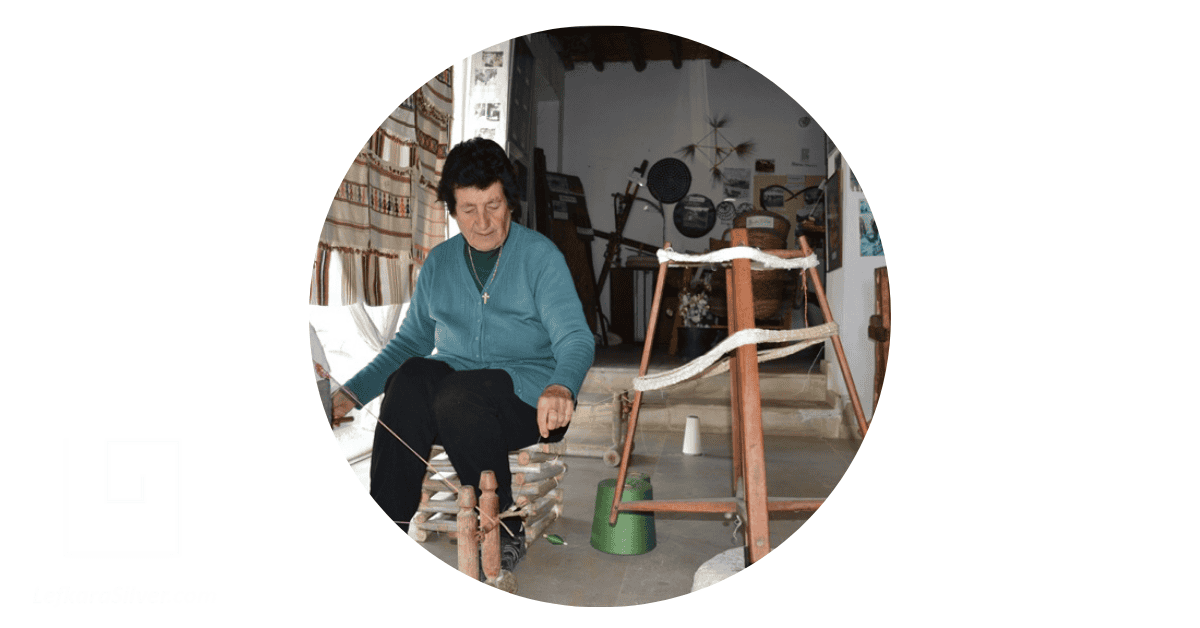
Now, let’s shift our focus from lace-making to weaving. In the Pafos district lies the village of Fyti, the undisputed champion of a textile art known as Fythkiotika. This isn’t lace at all, but a vibrant and colorful form of weaving with a history that stretches back to the Middle Ages. Its cultural significance is so great that it is also listed in the UNESCO National Intangible Cultural Heritage Catalogue.
Fythkiotika is immediately recognizable by its bold, colorful geometric patterns, known as “ploumia”, woven directly into the fabric. These designs are separated by distinct rows called “mostres”, and the finished edges are often adorned with hand-tied fringes called “klosia”. Unlike the delicate, monochrome elegance of Lefkara, Fyti weaving is a riot of color and exuberant design, a joyful expression of folk art.
Traditionally, this craft was a completely self-sufficient process. Weavers would cultivate their cotton, spin it into yarn, and then dye it before setting it on a loom. While ready-made thread is more common today, the weaving process itself remains a cherished skill. These textiles were not just decorative; they were functional items for the home, used as bed covers, tablecloths, and towels. Each piece of Fythkiotika is a vibrant and enduring thread in the rich tapestry of Cypriot culture, a colorful testament to the island’s enduring legacy of craftsmanship.
Cyprus Lace Techniques
To truly appreciate a piece of Cyprus lace, it is helpful to understand the incredible skill that goes into its creation. This isn’t just a craft; it’s an art form defined by precision and meticulous attention to detail. Understanding the techniques involved will not only deepen your admiration but also help you spot an authentic, handcrafted masterpiece from a mile away.
The entire process is a meticulous ritual. It starts with selecting the right material, which for authentic Lefkaritika is always high-quality linen from Ireland or France. The artisan then begins the painstaking process of creating the design by hand. This involves a combination of techniques: hemstitching for the borders, cut work where threads are snipped and pulled from the fabric to create open spaces, satin stitch fillings for dense, smooth patterns, and delicate needlepoint edgings.
The designs themselves are a stunning array of geometric patterns, often enclosing stylized flowers and motifs. This skill isn’t learned in a classroom but is passed down through generations, with young girls learning by watching their mothers and grandmothers before receiving formal instruction. Once mastered, the lacemaker can then inject her own personality into the designs, blending tradition with individual creativity.
| Lace Type | Origin | Characteristics | Preservation |
|---|---|---|---|
| Lefkara Lace | Pano Lefkara, Cyprus | A hand-made pulled-thread and cut-work embroidery on linen, featuring intricate geometric patterns, satin stitch, and needlepoint edgings. | Inscribed on the UNESCO Representative List of the Intangible Cultural Heritage of Humanity (2009). |
| Omodos Lace (Pipilla) | Omodos village, Troodos | A very fine and intricate needle lace known as pipilla or narrow-knit lacing, created with a needle and thread. | The tradition is sustained and promoted at the Omodos Centre for the Preservation of Lace. |
| Fyti Weaving (Fythkiotika) | Fyti, Paphos district | Not a lace but a distinct weaving craft. Woven on a loom and characterized by its vibrant colors and bold geometric patterns. | Listed in the UNESCO National Intangible Cultural Heritage Catalogue, with traditions upheld by weavers often trained by the Cyprus Handicraft Service. |
Unique Cyprus Embroidery
What makes Cypriot embroidery, particularly Lefkaritika, so unique is its rich tapestry of influences. The patterns are a cultural melting pot, blending indigenous craft with the sophisticated embroidery of Venetian nobles who ruled Cyprus from 1489, all laid over a foundation of ancient Greek and Byzantine geometric designs. This results in lace characterized by its traditional white, brown, and ecru colors, as well as its distinctly geometric feel.
The creation of Lefkara lace is a marvel of mathematical precision. The process involves meticulous thread counting, which is why the shapes are predominantly geometric in nature. The embroidery consists of two core elements: designs stitched directly onto the fabric with satin stitch, and the even more complex cut-and-drawn designs, created after specific threads have been painstakingly removed from the linen base.
The real charm lies in the names given to these patterns, which often reflect everyday objects.
- Satin stitch designs include whimsical names like “margarites” (daisies) and “koukouvaes” (snails).
- Cut-and-drawn designs are often named for what they resemble, such as “tagiades” (cut designs).
A hallmark feature you’ll always find on genuine Lefkaritika is the “potamos” (the river), a distinctive zigzag pattern created by cutting and drawing threads. This river runs parallel to the outer edges of the fabric, and its triangular arches are filled with various intricate designs. This is a non-negotiable element of authentic Lefkara lace.
The Influence of Cyprus Lace on Fashion

For centuries, Cyprus lace was primarily a domestic art, used for dowries, home decoration, and religious vestments. But today, this time-honored tradition is being beautifully woven into the fabric of modern fashion, adding a touch of heritage and timeless elegance to contemporary design. Designers and artists are finding fresh ways to interpret this delicate craft for a new generation.
You can see the influence in various ways. Some designers go bold, using lace as a statement piece to create stunning dresses or tops with full lace bodices that evoke a sense of romance and femininity. Others prefer a more subtle approach, using lace as delicate trim on sleeves, collars, and hemlines to add a touch of texture and visual interest to an otherwise simple garment.
The versatility of the lace allows it to fit into styles ranging from bohemian chic to classic elegance. You can find a rich collection on Etsy.
This incorporation into modern fashion is more than just a matter of aesthetics; it’s a vital act of cultural preservation. Contemporary artists like Marina Xenofontos are using embroidery to explore and embroider new histories, connecting the past with present-day narratives. By giving this traditional craft a place on the modern stage, designers and artists are not only creating beautiful pieces but also helping to preserve this precious cultural heritage, ensuring its story continues to be told in a fast-paced, modern world.
Cyprus Lace Tourism Tips
So, you’re ready to dive headfirst into the captivating world of Cyprus lace? Excellent choice. To make your journey as rich and authentic as the textiles themselves, here are a few insider tips to guide your exploration.
Go Straight to the Source: Visit Lefkara Village
This is non-negotiable. The village of Lefkara, split into Pano (upper) and Kato (lower) Lefkara, is the undisputed heartland of this ancient craft. Located in the Larnaca region on the slopes of the Troodos mountains, this picture-perfect village is world-famous for its dual traditions: lace embroidery and filigree silver. Wander the cobbled streets and you’ll witness the magic firsthand, with women sitting outside their shops and homes, their fingers dancing as they create intricate patterns. It’s a living museum and a shopper’s paradise all in one.
Time-Travel in a Museum
For a deeper appreciation of the craft’s history, visit the Lefkara Museum of Traditional Embroidery and Silversmithing. Housed in a beautifully preserved 19th-century residence, the museum showcases stunning antique lace pieces, allowing you to see the evolution of the patterns and techniques over the centuries.
Get Your Hands on the Craft
Why just watch when you can do? Keep an eye out for lacemaking workshops. Getting a hands-on lesson from a local artisan is an unforgettable experience. You’ll learn the basic stitches and gain a profound respect for the skill involved. Plus, you get to create your own small piece of lace—a souvenir that truly holds a story.
Venture Off the Beaten Path
While the main streets of Lefkara are lined with beautiful shops, don’t be afraid to explore the side alleys. Sometimes, the most authentic finds and genuine conversations are found in smaller, family-run workshops. Additionally, consider visiting other craft villages, such as Omodos for its pipilla lace or Fyti for its vibrant weaving, to experience the diversity of Cypriot textile arts.
Respect the Art
Remember, authentic Cyprus lace is a delicate work of art, not a mass-produced trinket. The high price tag reflects the hundreds of hours of meticulous labor, the high-quality linen, and the generations of skill invested in each piece. Handle the items with care, listen to the stories from the artisans, and appreciate that you are purchasing a piece of living history.
The Future of Cyprus Lace
And there you have it—a journey through the delicate, intricate, and deeply significant world of Cyprus lace. We’ve untangled the data in our Cyprus lace statistics, pointed you to the 7 must-visit lace shops, and traveled back in time to uncover the history of Cyprus lace. We’ve pinpointed the best lace-making villages, such as the proud Lefkara, the charming Omodos, and the colorful Fyti. We’ve examined the unique lace techniques and embroidery of Cyprus, traced their influence on modern fashion, and provided you with our top tourism tips.
While the tradition is strong, the future of this time-consuming craft faces challenges from mass production and a world that often prizes speed over skill. The survival of Lefkaritika and other Cypriot textile arts depends on a new generation of artisans and on visitors and buyers like you who appreciate and support true craftsmanship.
Here are a few fascinating facts to take with you:
- The tradition of Lefkara lace dates back to at least the 14th century.
- In 2009, Lefkaritika was inscribed on the UNESCO Representative List of the Intangible Cultural Heritage of Humanity.
- According to legend, Leonardo da Vinci bought a Lefkara lace altar cloth in 1481 for the Duomo in Milan.
- A key feature of all authentic Lefkara lace is the “potamos” or “river,” a cut-and-drawn zigzag pattern.
- The colorful, woven fabrics from the village of Fyti, known as Fythkiotika, are also recognized on the UNESCO Intangible Cultural Heritage list.
- It can take a skilled artisan more than a year to complete a single large, intricate tablecloth.
All information in this guide is current as of September 2025.
The story of Cypriot craftsmanship is one of constant evolution, blending ancient techniques with modern style. To see how these intricate patterns inspire breathtaking jewelry, follow our journey at Lefkara Silver. You’ll be the first to know about new collections in the Silver Jewelry Catalogue, exclusive offers, and more stories from the heart of Cyprus.
Cyprus Lace FAQs
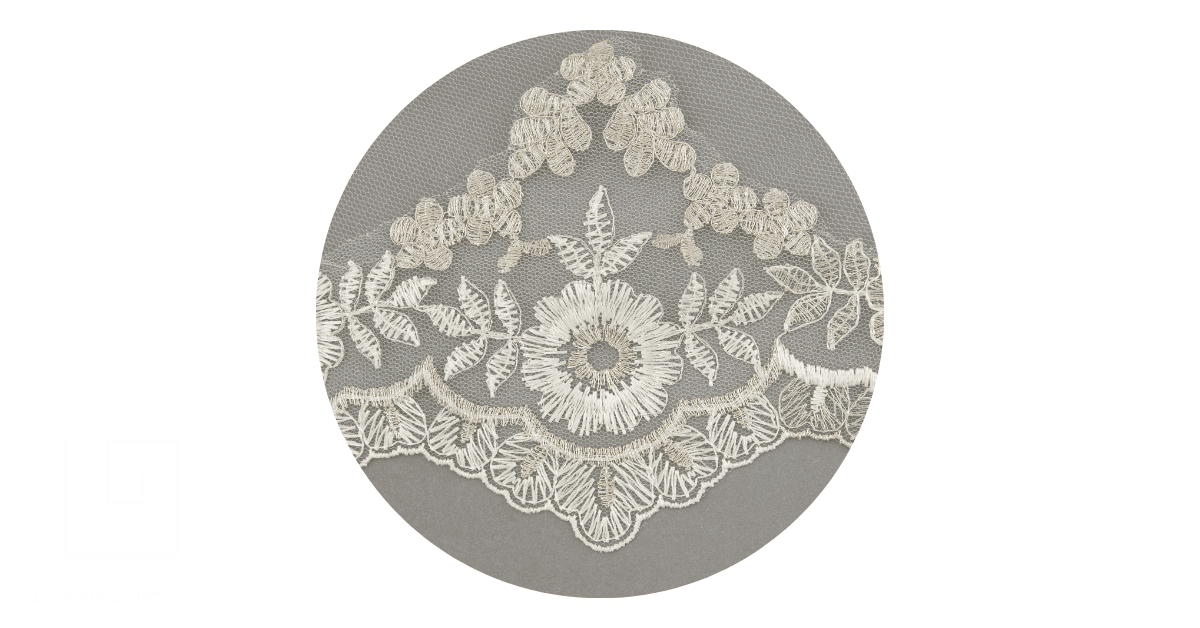
What Is The History Of Cyprus Lace?
The history of Cyprus lace, particularly the renowned Lefkaritika, dates back to the village of Lefkara as far as the 14th century. This intricate craft evolved significantly during the Venetian period, which began in 1489, by merging local embroidery techniques with the needlework of Venetian noblewomen. A testament to its historical significance, tradition holds that Leonardo da Vinci purchased a lace altar cloth here in 1481, and in 2009, UNESCO inscribed the craft on its list of Intangible Cultural Heritage.
How Is Cyprus Lace Made?
The creation of Lefkara lace is a highly meticulous handcraft known as pulled-thread work. Artisans begin by painstakingly cutting and pulling out designated threads from a piece of linen to form a grid. The remaining threads are then intricately embroidered over with fine cotton thread, using more than 10 distinct types of stitches to create complex geometric patterns. This process is so labor-intensive that a single large tablecloth can take a skilled lacemaker over a year to complete.
What Are The Different Types Of Cyprus Lace?
Cyprus boasts at least three celebrated and distinct textile traditions. The most famous is Lefkaritika from Lefkara, a pulled-thread embroidery with over 600 documented motifs. The village of Omodos is the center for Pipilla, an intricate and delicate form of needle lace made with just a needle and thread. Lastly, the town of Fyti is renowned for Fythkiotika, which is not a type of lace but a vibrant, colorful, woven fabric with geometric patterns created on a loom.
Where Can You Buy Authentic Cyprus Lace?
The most reliable place to purchase authentic Cyprus lace is directly from the artisan workshops in the craft’s village of origin, Pano Lefkara. This mountain village has dozens of shops where you can often see the lacemakers demonstrating their skills. Reputable museums, like the Museum of Traditional Embroidery and Silversmithing in Lefkara, house exceptional examples dating back to the 19th century, setting a benchmark for the quality you should look for.
How To Identify Genuine Cyprus Lace?
To identify genuine Lefkara lace, first, inspect the reverse side; it should be almost as neat as the front, which is a key indicator of expert hand-stitching. An authentic piece will be made on pure linen and will exhibit the slight, charming irregularities of handmade work, unlike the perfect uniformity of a machine-made item. Critically, every genuine Lefkara piece must feature the “potamos” (river), a distinctive zigzag cut-work pattern that borders the main design.
What Materials Are Used In Cyprus Lace Making?
The foundational material for authentic Lefkaritika is high-quality linen, traditionally imported from either Ireland or France. The intricate embroidery work is then meticulously executed using fine cotton thread, almost always in traditional colors of white, brown, or ecru. The craft is so specific that only these three colors are typically used for the stitching.
What Are The Traditional Patterns In Cyprus Lace?
Traditional patterns in Lefkara lace, or Lefkaritika, are purely geometric and incredibly diverse, with over 600 different motifs documented. These designs are often inspired by nature and daily life, with names like “margarites” (daisies) and “koukouvaes” (snails). The most crucial and defining pattern, however, is the “potamos” (river), a zigzag cut-work design that must be present on any authentic piece of Lefkara lace.
How Has Cyprus Lace Evolved Over The Years?
Cyprus lace has evolved significantly since its origins in the 14th century, primarily through the incorporation of outside influences into its local craft. The biggest transformation occurred after 1489 with the arrival of Venetian nobles, whose intricate embroidery inspired Cypriot artisans to adapt and innovate, leading to the birth of Lefkaritika from an older style called “asproploumia”. While the core techniques remain unchanged, modern artisans sometimes incorporate lace into contemporary items, extending beyond traditional tablecloths and dowry pieces.
What Is The Cultural Significance Of Cyprus Lace?
The cultural significance of Cyprus lace is immense, serving as a primary symbol of identity for the women of Lefkara for over 600 years. Historically, it was a young woman’s most prized dowry possession and a main source of income, with men known as kentitarides traveling across Europe to sell the lace. Its importance was globally recognized in 2009 when UNESCO added Lefkaritika to the Representative List of the Intangible Cultural Heritage of Humanity.
How To Care For And Preserve Cyprus Lace?
To preserve a piece of precious Cyprus lace, it must be hand-washed with extreme care using lukewarm water and a mild, neutral soap. Never wring or twist the fabric; instead, gently press the water out and lay the piece flat on a clean white towel to air dry, away from direct sunlight. For long-term storage, it is best to roll the lace around a tube, cushioned with acid-free tissue paper, to prevent permanent creasing.
What Are The Most Famous Cyprus Lace Designs?
Among the hundreds of intricate designs, the single most famous and essential pattern in Lefkara lace is the “potamos,” or the river. This iconic zigzag pattern, created using a meticulous cut-and-drawn thread technique, is a mandatory element that borders the main motifs of any authentic piece. Other well-known stylized patterns include “margarites” (daisies) and designs that resemble common insects or architectural shapes, often passed down through at least 4 generations.
How Does Cyprus Lace Differ From Other Lace Types?
Cyprus lace, specifically Lefkaritika, is fundamentally different from many other European laces because it is a form of embroidery on fabric, not a lace built from scratch. Unlike bobbin lace, which is woven with bobbins, or needle lace like Cyprus’s own pipilla lace, which is created with a single needle and thread, Lefkara lace is a pulled-thread technique. Artisans achieve the “lacy” look by expertly cutting and pulling threads out of a solid piece of linen and then embroidering the remaining threads.
